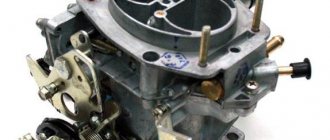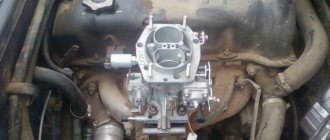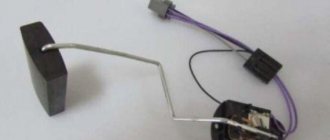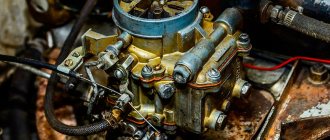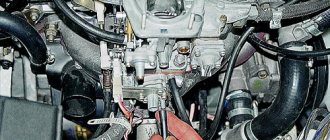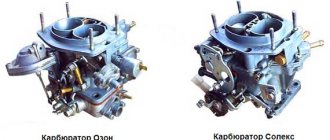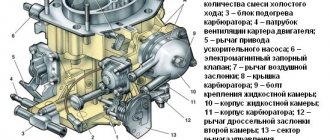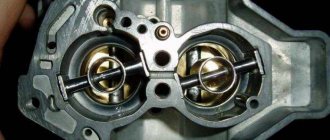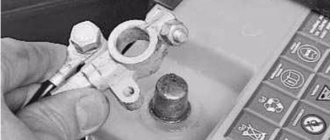VAZ 11113
Adjusting the carburetor drive
Performed when replacing the carburetor
, as well as when drive parts are worn or replaced.
- When the gas pedal is fully pressed, the throttle valves should be fully open, and when released, they should be closed.
- If this is not the case, by unscrewing or tightening the adjusting nuts on the front end of the drive cable (carburetor side), we achieve the correct position of the throttle valves.
- The tension of the cable with the pedal fully released is checked as follows: we pull the cable in the middle of the branch near the carburetor by about 10 mm, while the throttle valves should not open. If you pull the branch back a large amount (about 15 mm), they should begin to open slightly.
Adjusting the fuel level in the float chamber
Performed when replacing a needle valve or float (see also “Diagnostics of engine malfunctions”).
- We remove the carburetor cover (see “Disassembling the carburetor”) and measure the protrusion of the needle valve above the cover, which should be 10 mm. If this is not the case, replace the gasket or valve with gasket.
- Having placed the float with its lower part on a flat surface, measure the distance from it to the center of the float axis. It should be 23.1 mm. We adjust the size by bending the lever.
- We measure the distance from the tongue to the top plane of the float, which should be 2.0 mm.
- A drill can be used as a gauge.
- We adjust the distance by bending the tongue. In this case, its supporting surface must be perpendicular to the axis of the needle valve.
Adjusting the starter
Performed on a removed carburetor.
- When turning the choke control lever counterclockwise all the way, the choke should close completely. If it does not close, eliminate the cause of the jam (or straighten the deformed valve).
- With the air damper completely closed, the throttle valve of the first chamber must be slightly open to the starting gap C (see figure).
- This gap is adjusted by turning the screw on the throttle drive lever with a thin slotted screwdriver.
- With the air damper completely closed, press manually (you can use a screwdriver, stick, etc.) on the trigger rod until it stops. In this case, the air damper should open slightly to the starting gap (see table above). We use a drill as a gauge.
- To adjust the gap, use an “8” wrench to loosen the lock nut of the screw located on the starter cover. Inserting a thin slotted screwdriver into the slot, unscrew (to increase the gap) or tighten (to decrease the gap) the screw, and then tighten the locknut.
Starting device: 1 - starting device lever; 2 — throttle valve; 3 - thrust screw for opening the throttle valve; 4 — lever on the axis of the throttle valve of the first chamber; 5 — starter control cable: 6 — lower edge of the cam groove; 7 — upper edge of the cam groove: 8 — air damper spring; 9 - air damper: 10-lever on the air damper axis; 11 — trigger diaphragm rod: 12 — trigger diaphragm: 13 — diaphragm thrust (adjusting) screw; 14 — screw for fastening the trigger lever; B - starting gap of the air damper; C - starting gap of the throttle valve.
Adjusting the idle system
Performed during maintenance or engine malfunctions (see “Diagnostics of faults”).
- The adjustment is performed on a warm engine. At the factory, the engine is adjusted to a minimum crankshaft speed of 820-900 rpm and a carbon monoxide (CO) content of 0.5-1.2%, after which a restrictive plastic sleeve is pressed onto the screw head. If by turning the bushings it is not possible to restore the factory adjustment parameters, we unscrew the screw, breaking the bushing, then by rotating the quantity screw we set the crankshaft speed, and by turning the quality screw we set the content of carbon monoxide in the exhaust gases.
- When you press the gas pedal, the engine should increase the crankshaft speed without interruption, and when you release the pedal, it should not stall.
- When turning the quantity screw clockwise, the crankshaft speed increases.
- When turning the quality screw clockwise, the CO content in the exhaust gases increases.
Adjusting the OKA carburetor
- The choke lever is turned counterclockwise all the way and held. In this position, the carburetor air damper should be tightly closed.
In the lowest position of the lever, the carburetor flap of the OKA car must be completely closed
The carburetor starting rod on the OKA car is recessed with a flat screwdriver until it stops
The gap on the air damper of the carburetor OKA is measured with a feeler gauge
How to set a carburetor without a strobe for efficiency
The carburetor is responsible for creating and supplying the internal combustion engine with an air-gasoline mixture corresponding to the speed limit, as well as for its reliable starting at any temperature. Despite the widespread introduction of fuel injection systems, carburetors will be in demand for a long time on the VAZ 2107, -2106, -2109 and their more modern counterparts. Their popularity is due to their relatively low price and the ability to customize the engine operating mode to best suit the owner’s driving style.
The carburetor is responsible for reliable engine starting at any air temperature
Advantages and disadvantages
Solex has certain inevitable disadvantages, but there are also positive qualities for which owners of domestic cars love them:
- High quality build. This includes everything related to materials and the precision of manufacturing of all parts. There is no need to “finish with a file” what is already well done;
- Better fuel mixing performance. Since the design of the diffusers is much better thought out than in OZONE carburetors, with proper tuning you can achieve better power output with lower fuel consumption;
- The ability to modify and adjust the carburetor, achieving optimal operating parameters;
- Maintainability and low cost of spare parts. Compared to modern injection engines, repairing a Solex carburetor is much easier and cheaper;
https://www.youtube.com/watch?v=http:fyxl5qUbKG8
Today you can hear that carburetor cars are a thing of the past. This is partly true, because new standards, including environmental ones, and progress have long dictated a new perception of convenience and comfort. Injectors operate more economically, adapt more accurately to external conditions, and meet new requirements.
How long will the Solex carburetor remain relevant? Given its reliability and convenience, cars with this fuel supply system will be in use for a long time. So far, the interest in servicing and repairing the Solex has not waned, since there are quite a lot of cars with it.
How to set up a carburetor
The carburetor is one of the most complex components of a modern car, allowing the use of a particular engine with maximum efficiency. It is the correctness of its adjustment that determines fuel consumption and the content of toxic substances in exhaust gases. Regardless of the specific model of carburetor and car, it is possible to correctly adjust the parameters of the air-gasoline mixture only using a gas analyzer and professional measuring equipment. It is advisable to adjust the carburetor for efficiency after any work on the engine.
However, you can adjust it to your driving style yourself.
Video tutorial on how to clean and adjust a VAZ carburetor
In this case, you should follow the basic rules:
- The carburetor can be adjusted only after the engine reaches operating temperature;
- You should check and clean all high-voltage wires, as well as battery terminals;
- It is necessary to make sure that the fuel supply system is working properly and that the ignition is set correctly. You can start adjusting only after making sure that all other systems are working properly. Often the cause of dips and poor response to the pedal is simple contamination of the mesh filter;
- During adjustment, it is advisable to turn on all powerful consumers of electricity: high beams, stove, heated windows, etc.;
- Before disassembling and cleaning the carburetor, it is advisable to purchase a repair kit for a specific model. It contains jets, sealing gaskets, diaphragms of the accelerator pump, starting device and other auxiliary elements;
- It is unacceptable to use rags, brushes or metal wire to clean internal surfaces. The best option is to use compressed air.
SOLEX is a popular manufacturer of carburetors for domestic cars
The main manufacturers of carburetors for domestic cars are Ozon, Weber, PeKAR (K151) and Solex (SOLEX). There are no fundamental differences in their adjustment. However, it must be taken into account that all modifications of the Solex 2108 carburetor have different calibration data, which is caused by their widespread use on VAZ, ZAZ and AZLK vehicles.
Standard carburetor models
C were installed not only on VAZs. Other automakers also actively used them for their cars.
| Modification | Applicability | Engine volume, cm3 | Notes |
| DAAZ-2108–1107010 | VAZ 2108, 2109 | 1,3 | |
| DAAZ-21081–1107010 | VAZ 21081, 21091, ZAZ 1102 | 1,1 | |
| DAAZ-21083–1107010 | VAZ 21083, 21093, 21099 | 1,5 | |
| DAAZ-21083–1107010–31 | VAZ 2108, 2109, 2110, 2111 | 1,5 | Has a semi-automatic starting device |
| DAAZ-21083–1107010–35 | VAZ 2108, 2109, 2110, 2111 | 1,5 | Has a two-level semi-automatic starting device (winter/summer) |
| DAAZ-21083–1107010–62 | VAZ 2109, 2115 | 1,5 | Has an electronic device for controlling the composition of the combustible mixture |
| DAAZ-21083–1107010–05 | VAZ 2109 | 1,5 | |
| DAAZ-21412–1107010, DAAZ-21412–1107010–30 | AZLK 2141, 2141–23 | 1,5/1,8 | |
| DAAZ-1111–1107010 | VAZ 1111, 11113 "Oka" | 0,65/0,75 | |
| DAAZ-21051–1107010 | VAZ 2103, 2105 | 1,5 | |
| DAAZ-21053–1107010 | VAZ 21074, 21061 | 1,6 | |
| DAAZ-21051–1107010–30 | VAZ 2104, 2105 | 1,3 | |
| DAAZ-21053–1107010–62 | VAZ 2107, 21072, 21074 | 1,3/1,5/1,6 | |
| DAAZ-21073–1107010 | VAZ 2121, 21213 "Niva" | 1,6/1,7 |
Various carburetor models are focused on the environment, reducing consumption or maximizing vehicle dynamics. Carburetors were also created for engines of different sizes. Some models of carburetors from one power unit can be easily installed on another, and in some cases modifications will be required.
DAAZ carburetors (Dmitrov Avtoaggregatny Zavod) 2101, 2103 and 2106 were products that were produced thanks to a license from Weber. For this reason, the models are called both the DAAZ carburetor and the Weber carburetor, but they mean the same device. These carburetor models are characterized by maximum simplicity of design and provide excellent acceleration characteristics.
Carburetor Ozone
VAZ 2105-2107 models received improved DAAZ carburetors. This carburetor model is also called Ozone. The Ozone carburetor got its name due to its environmental friendliness. A fully serviceable and tuned Ozone carburetor allows you to reduce consumption from 7 to 10 liters of gasoline per hundred kilometers compared to Weber and is capable of providing good dynamics.
Among the disadvantages of this model is the design of the carburetor. The process of active operation leads to a number of problems with the secondary camera. The opening of the chamber does not occur mechanically, but thanks to a pneumatic valve.
Solex carburetor
No less popular is the DAAZ 21053 carburetor model, which is a licensed product from Solex. The carburetor has proven itself to be an economical and at the same time dynamic solution when installed on classic engines. The design of this model is very different from previous DAAZ carburetors.
Do-it-yourself adjustments without disassembling the carburetor
Most carburetors are available for adjustment without disassembly:
- A screw that allows you to adjust the idle speed;
- A screw that allows you to adjust the enrichment of the gasoline-air mixture at idle;
- Throttle valve locking screw of the first chamber;
- Idle jet holder.
In most cases, experimentally, using only these elements, it is possible to significantly improve engine performance. It is advisable to set the idle speed to 800÷900 in the summer, and 900÷1000 in winter.
The carburetor can be adjusted optimally for efficiency at the service station.
Very often, the quality of the mixture entering the engine can be judged by the deposit on the spark plugs:
- Slight gray-brown soot indicates good quality of the mixture;
- Black color indicates a significant excess of fuel;
- White - about excess air.
The use of the IKS-2 indicator, installed instead of a standard spark plug and allowing you to see the color of the flame, is often recommended for adjusting the quality of carburetor operation. However, practice has shown that using it to achieve a minimum level of exhaust toxicity is very difficult.
Using your car's tachometer, you can adjust the idle speed without a strobe light. However, it is advisable to optimally configure the carburetor for efficiency and absence of harmful emissions at a service station. Despite well-described methods for tuning all models of carburetors, it is always difficult to get to the stand of a qualified carburetor technician.
Actual gasoline consumption on the Oka River
During the operation of the car, owners are faced with the problem of increased fuel consumption. The main reasons for this are overload and improper throttle control (during factory tests, professional testers are behind the wheel).
As the piston group and valves of the gas distribution mechanism wear out, the compression ratio drops and engine power decreases, which leads to additional fuel costs.
Oka with a 0.6 l engine
Actual fuel consumption on cars with a VAZ-1111 engine:
- In city mode, the adjusted engine consumes up to 7 liters of fuel in summer; in winter, the parameter increases to 8 liters due to the need to warm up the engine and slow down the traffic flow. As parts of the power plant and chassis wear out, fuel consumption reaches 9 liters.
- On the highway, the minimum consumption of 3.5-4 liters is achieved at 60-70 km/h; increasing the speed to 90-100 km brings gasoline costs to 6 liters per 100 km. Accelerating a car to maximum speed leads to an increase in consumption to 8-9 liters (due to the increased crankshaft speed and increasing aerodynamic drag).
- In the combined cycle (50% of city mileage), the car requires 6-7 liters of fuel (depending on load and ambient temperature).
0.7 l engine
When using a carburetor VAZ-11113, the consumption during operation is:
- In city traffic, the car consumes about 8 liters of gasoline with an octane rating of 92 or 95 units (the increased cylinder capacity negatively affects engine efficiency). Sharp acceleration or operation in winter leads to an increase in consumption to 9 liters.
- The additional power has a positive effect on gasoline consumption on the highway, which is in the range of 4.5-5.5 liters per 100 km at speeds of 80-90 km/h. Acceleration to 110-120 km/h leads to an increase in fuel costs to 6.5-7 liters.
- In an average driving cycle, a car requires 7-7.5 liters of fuel per 100 km in summer and up to 8-8.5 liters in winter.
Engine 0.8 l
When using a Chinese engine with distributed injection, fuel costs are:
- In urban conditions with a short-term warm-up of a cold power plant (for 10-15 seconds before starting to move), gasoline costs are 7.5-8 liters, which is lower than the characteristics declared by the factory. As the engine wears out or if the throttle assembly becomes dirty, the consumption reaches 8.5-9 liters of fuel.
- On the highway, with the cabin fully loaded (4 adults) and a speed of 90 km/h, the car burns about 6 liters of fuel. The increased torque power allows you to accelerate the car to 150 km/h, consumption in this mode reaches 10-11 liters of gasoline.
- In mixed operating mode, the engine consumes 7.5 liters of fuel, the fuel reserve is enough for 420-430 km without refueling.
Engine carburetor 1.0 l
The installation of MeMZ-245.1 engines with a reduced compression ratio, designed for A-80 gasoline, was carried out from Naberezhnye Chelny. Small-scale vehicles are rare, which determines the small amount of information about actual fuel consumption. According to owners' reviews, in city traffic the car can handle 6.5 liters of fuel, and on the highway at 90 km/h gasoline costs do not exceed 4.5 liters.
The use of a 5-speed gearbox helped improve efficiency, but the crankcase of the unit did not fit in the engine compartment of the car.
Adjusting the carburetor float mechanism
Adjusting the float mechanism is a very important and at the same time simple operation when servicing a carburetor. Due to the design of the float mechanism, errors made here are most often the cause of its unsatisfactory operation.
The adjustment is performed with the cover removed and includes two operations:
— checking the degree of protrusion of the needle ball;
— adjusting the position of the float bracket tongue.
The first operation is performed to determine the condition of the needle damping ball and the resulting ability to make subsequent adjustments. At the same time, on the cover removed from the carburetor, measure the distance from the plane of the gasket to the ball protruding from the needle. A distance of 10 mm is considered normal. With a smaller size, you can install an additional gasket under the needle seat.
Before checking the fuel level, first unscrew the carburetor cover mounting screws, leaving the two middle screws tightened. Also, loosen the screw securing the clamp on the fuel hose. Then manually pump up the fuel with a fuel pump until the float chamber is completely filled; As quickly as possible, to prevent “excess” fuel from penetrating into the float chamber, remove the hose from the fuel supply fitting.
If the measured value does not correspond to the tabulated data, bend the float tongue; To lower the level, bend the tongue up, to raise it, bend it down. Before checking the level again with a rubber bulb or syringe, remove at least a third of the fuel from the float chamber.
Once correctly adjusted, the float mechanism remains for a very long time, being disrupted most often due to careless handling of the removed cover, as well as due to the natural wear of the rubbing parts of the mechanism: the needle locking cone, its seat, the tongue and the axis of the bracket.
In operation, there is usually no need to specially disassemble a properly functioning carburetor to check the adjustment; it is enough to combine its control with regular cleaning of the float chamber and air jets.
